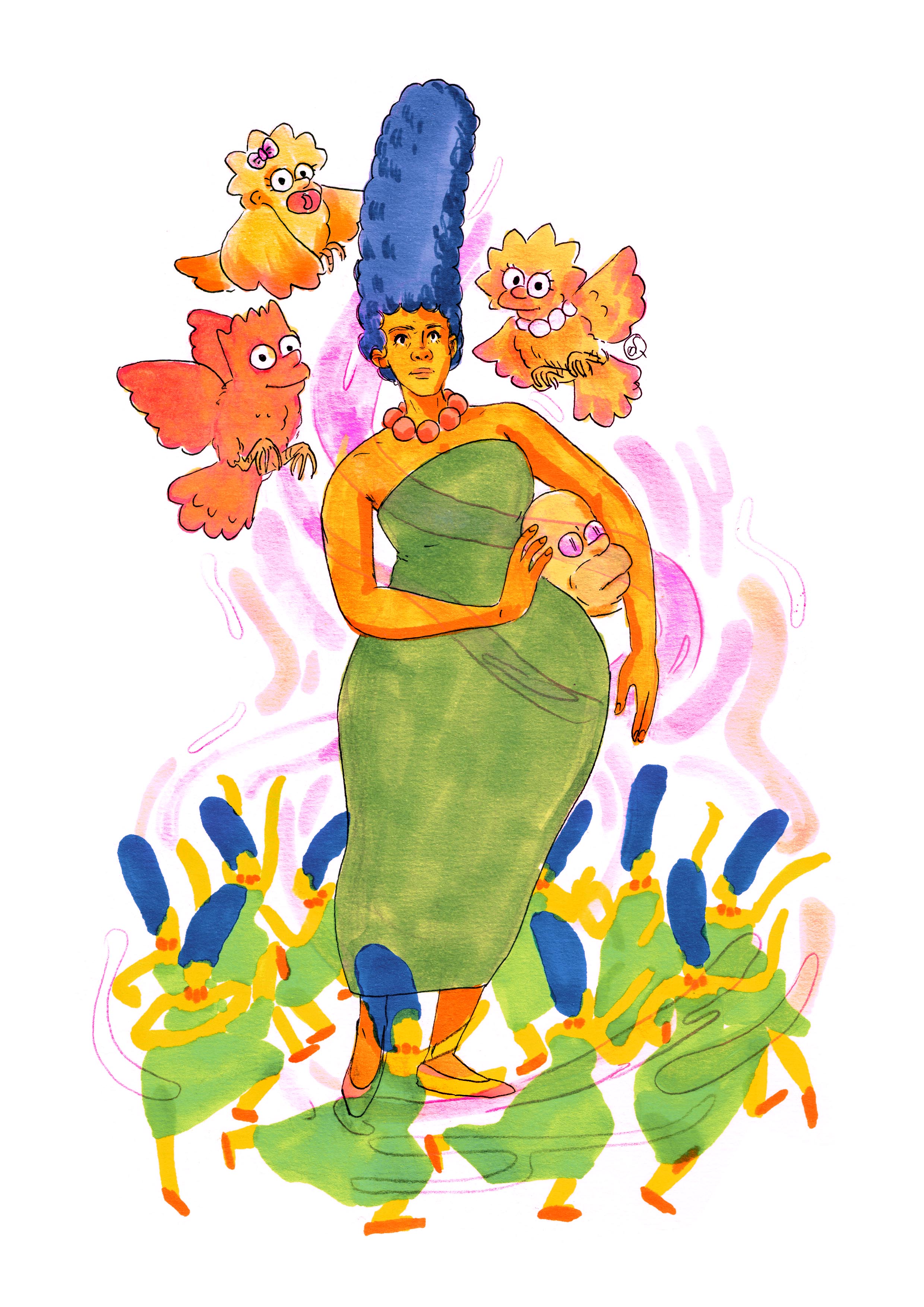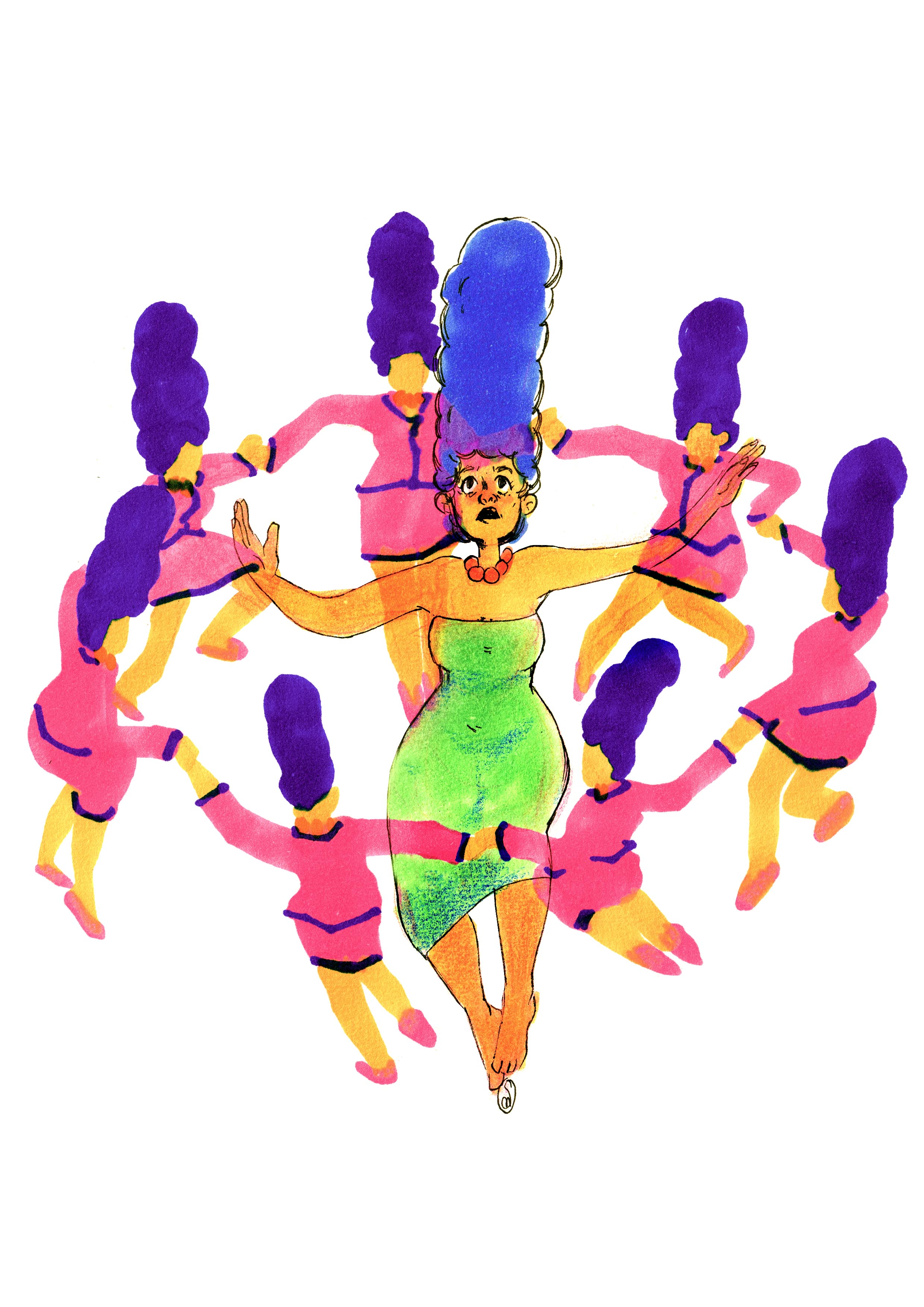Soolagna Majumdar is a Kolkata-born, Perth-based graphic designer, illustrator, and “soft artist”. Her latest project is “Marge Simpson Anime“—a watercolour reimagining of Marge Simpson in the style of shoujo and josei manga, mixed with a twist of Goya-esque surrealism.
The work is an exploration of shifting identities, queer awakenings, non-typical bodies, and embattled womanhood. It’s a radical reinterpretation of Marge that goes beyond the hetero-Western perspectives that inform our common conception of her, television’s most famous suburban wife and mother. In these images, we see her free of the family members she serves in the show.
Videos by VICE
Creators chatted to Majumdar about her creative process and the complex appeal of Marge Simpson as subject and object.
Creators: How has manga shaped your interpretation of Marge aesthetically and emotionally?
Majumdar: Marge would be the ideal josei manga [manga aimed at female readers] heroine, because so many of the iconic stories in the genre are all about this visual representation of being liberated from a quiet, almost ignored tragic existence. It was hard not to incorporate those flowing visual elements like floating petals and turning objects into panels, huge close ups and this general feeling of being in a huge dream sequence.

Why paint Marge? How does she appeal to you?
It’s not so much the appeal but what I remember of the show. And I remember her. She’s tragic, and her kind of tragedy is the kind I’ve seen and experienced in my own life. She’s taken for granted, passed off as a silly mom. [My work] explores the idea of what would it look like if the Marge in our own lives, in ourselves, was truly free.
What are your thoughts on Marge’s femininity, sexuality, and overall identity?
The older I’ve gotten, the more I see her as a symbol of what it means to have your whole identity formed by patriarchy, the culture of heterosexuality and these obscure sacrifices I find so many women in my own life making just so they can be compatible with this system.
I think it would be too painful for me to explore the kind of woman I might have been if the systems of oppression we have in place didn’t exist, so the pain seems a little less when I explore the idea of liberation through her.

Your artworks are dreamy and a little sinister, but The Simpsons is a comedy. Is that contrast intentional?
I haven’t seen the show in over a decade, but I still remember those underlying feelings of “ouch” when something started playing off as comedy and after a few cycles in your head it escalates into something tragic. And I mean, that escalation can take years. I used to watch it heaps as a kid and was laughing at things like Bart being strangled. I could never do that now.
You can deconstruct The Simpsons pretty endlessly.
The cultural impact of The Simpsons is on a completely different level to anything else I’ve ever encountered, and it’s due to the public familiarity and obscurity. It’s possible to explore pretty much anything if you put enough thought about it through any of the characters.

Can you tell us more about the influence of manga on your work?
I grew up reading so much josei and shoujo manga—manga targeted towards women and girls. They aren’t all the same but artists within these genres have such a unique way of making the reader explore these huge emotions and it definitely influenced they I felt they should be expressed.
How does manga guide how you tell a story?
Work from Takaya Natsuki and Ai Yazawa and so many artists in those genres… they approach layout in a very personal manner and are willing to break these panel by panel conventions and just permit the panel to flow or float across the page according to the image or set of visual cues being presented. There’s an almost elemental type of motion that takes place in that kind of work that’s enabled me to embrace story telling where the focus is more on the emotional journey.

In many ways The Simpsons is one of the most complexly capitalist works of fiction: it’s at once a giant brand, while also a postmodern critique of capitalism at the same time. How have you responded to this idea in your work?
Honestly I don’t think I’ve even scratched the surface of what I want to explore. At the most, I see Marge’s existence to be a product of the subtle ways in which capitalism is the enemy of the heart. How we compromise parts of ourselves in pursuit of a “comfortable” existence.
You can find out more about Majumdar’s work here and buy her zine here.
Related:
Bill Plympton’s Newest Simpsons Couch Gag Is Gruesome
Lisa Simpson and Henri Matisse Buddy Up Across Organic Linen
See The Simpsons Converted Into Computer Code




